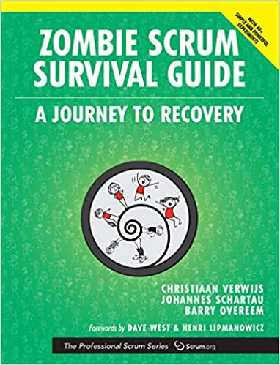| Zombie Scrum Survival Guide (Addison-Wesley) |
| Written by Kay Ewbank | |||
|
Author: Christiaan Verwijs, Johannes Schartau and Barry Overeem The idea behind this book is a fascinating one, and is almost certainly applicable to other areas. The authors set out to show that many projects that are apparently being developed using Scrum techniques are, in fact, zombie scrum. In other words, they look like scrum projects; they use all the right buzzwords, have people with the right job titles, but the results aren't showing the improvements that 'ought' to be there. The authors say this is because the process is a bit like adding the odd lettuce leaf to your diet while continuing to live on burgers and chips - an extra salad doesn't mean you're now eating healthily. In this book, they aim to show how to change from having zombie Scrum to real live Scrum.
The book opens with a 'getting started' chapter that outlines what the rest of the book is about, followed by a First Aid Kit chapter with a set of things to do to work out if your project is in fact a zombie, and what to do about it. Next comes a primer on zombie Scrum where the authors go in detail into the problems a team is likely to be encountering, and the symptoms to look out for - not knowing the needs of stakeholders, not shipping fast, not improving. The chapter continues with an experiment that will check the diagnosis. This part of the book ends with a chapter that looks at the purpose of Scrum to remind you what it should look like and achieve.
From here onwards the book concentrates on what Scrum originally promised, and how you can drag a zombie project back to those ideals. Each section from here onwards starts with a chapter looking at one aspiration of Scrum - fast shipping or continuous improvement, and the symptoms and causes of why that isn't happening. This is followed by a chapter of experiments designed to put things right by trying different ways of thinking and working. The relevant parts cover building what stakeholders need, shipping projects fast, improving continuously, and self organization. The book closes with a chapter on what to do on the road to recovery. I enjoyed this book. It's written in a light-hearted style, uses clear examples to illustrate the points being made, and definitely gets back to the spirit that underpinned the original reasons for Scrum. If you're part of a team that you fear has been turned into Scrum zombies, it might just save you.
To be informed about new articles on I Programmer, sign up for our weekly newsletter, subscribe to the RSS feed and follow us on Twitter, Facebook or Linkedin.
|
|||
| Last Updated ( Saturday, 24 July 2021 ) |

